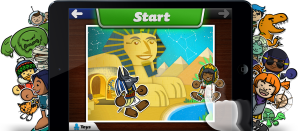Summer is just around the corner and with it comes the excitement of sunny days and a long break from school for our students. While we take time to appreciate summer’s myriad gifts, it is also important to ensure that reading is at the center of our summer activities. We must provide continuous access to books of all kinds so that our students will begin the new school year feeling enriched, prepared, and confident in their reading identities. We appreciate books that challenge us, inspire us, and call on our imaginations during those long, hot days. Below are some of our favorites!
Grades K-2
Knuffle Bunny by Mo Willems
Mo Willems is a popular and beloved author and Knuffle Bunny is a perfect example of why his words and stories are so appealing and so widely read. A routine trip to the laundromat becomes dramatic when the young protagonist, Trixie, leaves behind her beloved stuffed animal. Willems’ book is warm and enjoyable- just like summer!
Anna Hibiscus by Atinuke
The first in a series, Atinuke tells the story of Anna Hibiscus, a young girl who lives in Africa with her family. This book is a great resource for teaching children about another culture while emphasizing the universalities of every childhood. Readers will be eager to explore all of the books in the Anna Hibiscus series.
Dory Fantasmagory by Abby Henlon
Dory is spunky, curious, imaginative, and energetic. Her story is told in chapter book form, which makes Henlon’s book an excellent choice for a read-aloud or a great selection for independent readers in search of early and accessible chapter books. Dory’s enthusiasm is annoying to her siblings, Luke and Violet, but her silly questions and wonderings (“why do we have armpits?”) will make her a favorite among young readers.
The Adventures of Beekle: The Unimaginary Friend by Dan Santat
Beekle is a lovable and endearing protagonist in this unique and deeply engrossing picture book. Santat’s spin on the familiar concept of the “imaginary friend” is both whimsical and touching, and readers will embrace Beekle with open arms.
Lon Po Po: A Red-Riding Hood Story from China, by Ed Young
Winner of the 1990 Caldecott Medal, Young artfully tells the story of three sisters who encounter Lon Po Po, a wolf pretending to be their grandmother. Told from the point of view of the sisters, with beautiful and haunting panel illustrations, this twist on the classic Little Red-Riding Hood is emotionally textured.
Grades 3-5
The Tale of Despereaux by Kate DiCamillo
Kate DiCamillo’s tale of a mouse named Despereaux Tilling has garnered a great deal of well-deserved popularity and attention. Despereaux is no ordinary mouse; he can read and hear music and, most importantly, he can fall in love (with a Princess!). Despereaux’s big heart and unconventional courage make him a lasting and memorable hero.
The One and Only Ivan by Katherine Applegate
This Newbery Medal winning novel tells the story of Ivan, an artistic and creative gorilla who lives captive in a shopping mall. When Ivan meets Ruby, a baby elephant taken from her family, his life forever changes. The lessons Ruby teaches Ivan, and his transformative journey, will lead readers to think thoughtfully about human-animal relationships and the power of empathy and kindness. This is a perfect book for animal-loving readers.
Inside Out and Back Again by Thanhha Lai
This novel, told in verse, details the story of Hà and her move from Saigon to Alabama. Readers will learn about the real-life struggles of child refugees and their families. Lai’s words and narrative are beautiful, moving, and powerful.
Giants Beware! by Jorge Aguirre
This graphic novel centers around a lively protagonist named Claudette, who dreams of slaying a giant. The only problem is that there are no giants to be found near Claudette’s house- so she embarks on a journey to locate one. Readers will be drawn to the humor of Claudette’s adventures and the appealing graphic novel format.
Star Wars: Jedi Academy by Jeffrey Brown
This graphic novel is an especially good choice for fans of Star Wars, but all readers will enjoy the adventures of Roan, a middle schooler who is invited to attend Jedi Academy. Roan’s middle school trials and tribulations will feel familiar, but the backdrop of a “galaxy far, far away” make them remarkable and memorable.
Grades 6-8
When You Reach Me by Rebecca Stead
This award-winning novel will stay with readers long after they finish the last page. An homage to Madeleine L’Engle’s classic A Wrinkle in Time, Stead’s book is an enduring read that has entered into the pantheon of the classics in its own right. The friendship at the core of the novel is profound and complex and plants the book firmly in a sensitive and realistic world that will be familiar to many readers (despite the elements of mystery and fantasy that anchor the larger plot).
Brown Girl Dreaming by Jacqueline Woodson
This beautiful book is written in verse and is a must-read for students and adults alike. Woodson’s memoir, presented through lyrical and poetic language, is powerful and moving, and addresses challenging and complex issues with clarity and sensitivity. Eloquent and deeply affecting.
Harlem Summer by Walter Dean Myers
We love reading Walter Dean Myers’ books year round, but this one is especially perfect for summertime reading. This novel takes place during the Harlem Renaissance, and significant historical figures such as Langston Hughes make appearances throughout the book.
The Lightning Thief by Rick Riordan
This is the first installment in the Percy Jackson and the Olympians series, and its fast-paced fantastical tale makes for perfect summer reading. The Lightning Thief follows the story of Percy Jackson and his friends Annabeth Chase and Grover Underwood as they embark on a mission to find Zeus’ stolen lightning bolt. On their adventures the friends encounter minotaurs, centaurs, and a host of Greek gods and goddesses. Readers will connect with the realistic characters (for example, Percy is dyslexic and struggles with ADHD) and action-packed plots while learning a little about Greek mythology.
American Born Chinese by Gene Luen Yang
This graphic novel, through its moving images and thought-provoking stories, brilliantly connects three very different characters and their struggles: the famous folktale of Sun Wukong, “The Monkey King”; Jin Wang, a boy who starts at a new school where he wants to fit in with his classmates; and Danny, a boy whose life is turned upside-down by the visit of his Chinese cousin, Chin-kee. This graphic novel gracefully examines a range of hardships and joys, including exclusion, racism, friendship, and first love.





